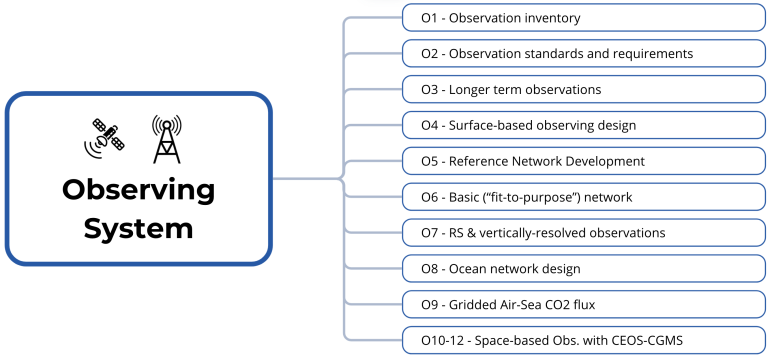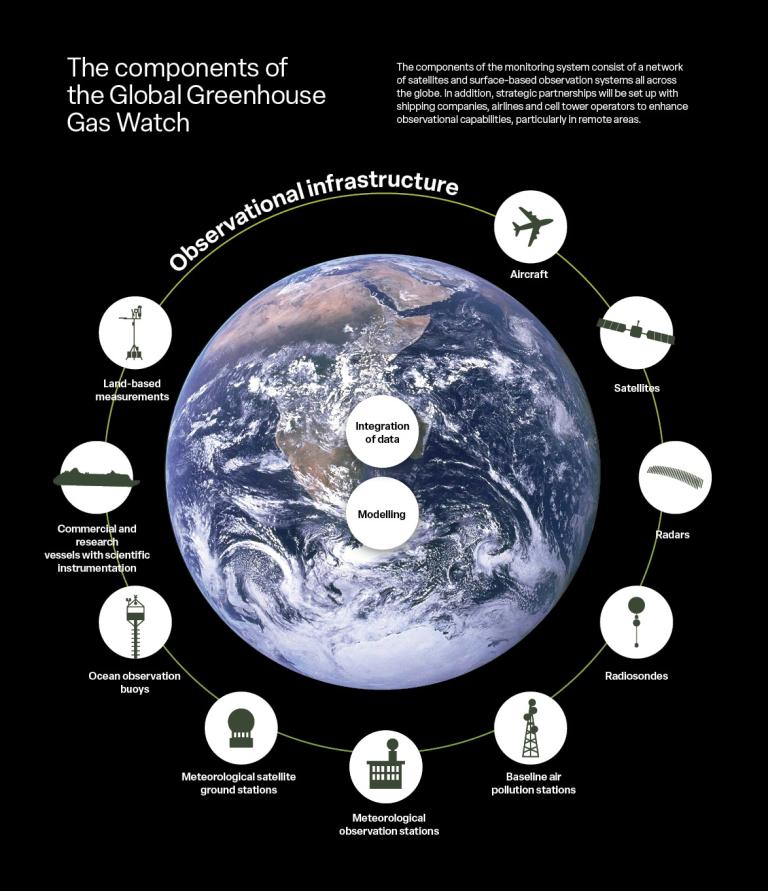Observing System
As the first stage of emissions monitoring process, observations are fundamental for G3W. Observations can come from a variety of sources : on ground, land or ocean surface; remote sensing and vertically resolved observations; from space with satellites.
The following action items were identified as priority activities for the advancement of implementation of G3W.

Theme 1: Cross-domain observing network design principles
Action O1: Create an exhaustive inventory of existing surface-based GHGs measurements
The activities involve surveying existing greenhouse gas (GHG) observations, evaluating available information in databases, performing a literature review to identify additional datasets, and conducting a gap analysis to compare required variables for inversion models with current measurements. Success will be measured by creating a comprehensive inventory of GHG measurements for integration into OSCAR and completing the gap analysis.
Action O2: Develop GHG monitoring standards and revise and reconcile existing GHG measurement requirements
The activities include creating a comprehensive set of GHG observation requirements, establishing a library of quality assurance guidelines, assessing observation quality, defining a tiered network structure, setting standards and operating procedures, and establishing network implementation principles. Success will be measured by the inclusion of observational requirements in the OSCAR/Requirements database, the creation of a QA/QC guidelines library, and the specification of the tiered network.
Action O3: Develop a road map for longer-term GHG observing activities.
The activity involves organizing a workshop to develop a long-term plan for a sustainable GHG observing network covering all Earth System components (atmosphere, ocean, land) for both ground-based and satellite systems. Success will be measured by the creation of a long-term strategy that addresses sustainable financing for the observing system.
Theme 2: Ground-based, near-surface, in situ measurements of GHGs
Action O4: Address existing spatiotemporal data gaps in ground-based near-surface GHG observations
The activities involve identifying gaps in spatiotemporal distribution, conducting network design experiments with the modeling community, finding deployment opportunities in gap areas, identifying partners and capacity building needs, linking with ocean and space-based networks, connecting with WMO resource mobilization, and evaluating opportunities for GHG observations in the Global Basic Observing System. Success will be measured by an efficient network design, updated technical regulations, and a list of deployment opportunities, with the process iteratively addressing evolving requirements.
Action O5: Develop sustainable high-quality reference GHG network
The activities include defining the Tier 1 ("high-quality") network and its technical regulations, updating WIGOS regulations, evaluating network requirements and deployment opportunities, assessing co-location possibilities, defining support infrastructure, developing a strategy for high-quality data, and conducting market research on suitable instrumentation. Success will be measured by the inclusion of Tier 1 network definitions and technical regulations in WMO Technical Regulations and the production of measurement guidelines for the highest tier network.
Action O6: Develop basic (“fit-for-purpose”) GHG network
The activities include defining the Tier 2 ("fit-for-purpose") network, evaluating co-location possibilities, conducting market research on instrumentation, engaging with instrument producers, and establishing and training a "community of practice" for citizen science. Success will be measured by the creation of guiding documentation for the Tier 2 observing system, an engagement strategy, and training materials for the community of practice. Additionally, early development of specifications for an economic air monitoring system is recommended.
Theme 3: Vertically resolved GHG observations, in situ and remote sensing
Action O7: Expand number of sites with vertically resolved and remote sensing GHG observations.
The activities include identifying key locations for vertical profiling, developing specifications for vertical profile measurements and observation techniques, and formulating recommendations for analyzing GHG vertical profiles. Success will be measured by the achievement of annual targets for profiling observations at sites according to the prescribed timeline and deployment methods.
Theme 4: Surface-based ocean observations
Action O8: Formalize and enhance a sustained surface ocean CO2 observational network.
The activities include designing a governance structure for SOCONET, implementing and expanding sustained infrastructure for reference measurements, developing optimal observing designs, and recommending infrastructure for CH4 and N2O observations. Success will be measured by the establishment of a governing body, a road map for sustained funding, plans to address observing gaps, increased data coverage, and the initiation and evaluation of CH4 and N2O observations at critical sites.
Action O9: Deliver routine global gridded products of air-sea CO2 flux.
The activities include formalizing SOCAT's governance structure, enhancing SOCAT's capabilities and interoperability, conducting Observing System Experiments (OSEs) to optimize observing network design, and developing a road map for sustained delivery of ocean CO2 and other GHG flux products. Success will be measured by the establishment of a governance structure, sustained funding for data management, defined observation coverage and frequency, and a clear pathway for integrated dataflow within the G3W framework.
Theme 5: Space-based observations of GHGs and related variables
Action O10: Liaise and prioritize with Committee on Earth Observation Satellites (CEOS) - Coordination Group for Meteorological Satellites (CGMS) for direct GHG observations from space.
The activities include establishing a collaboration between G3W and CEOS on the GHG Roadmap, integrating representatives from CGMS and CEOS into the G3W structure, and evaluating requirements for satellite observations. Success will be measured by the formation of a Joint Expert Team with CEOS, prioritized lists of space-based GHG and co-emitted species observations, and a comprehensive set of data requirements for model inversions over various terrains (land, ocean, ice).
Action O11: Liaise and prioritize with CEOS-CGMS for indirect GHG observations from space (required to infer GHG fluxes).
The activities include establishing collaborations on the CEOS AFOLU and Aquatic roadmaps, and identifying required variables for biosphere and ocean models. Success will be measured by the formation of a joint expert team with GCOS/TOPC and AFOLU, prioritized lists of space-based observations for AFOLU-related carbon monitoring and essential climate variables (ECVs), and a comprehensive set of data requirements for supporting model inversions.
Action O12: Liaise and prioritize with CEOS-CGMS for required space-based observations to monitor changes in the carbon cycle in a (future) changing climate.
The activities include identifying and prioritizing required space-based observations to monitor changes in the carbon cycle, evaluating existing observations, and reviewing planned missions to fill gaps. Success will be measured by prioritized lists of future space-based observations for continuity and gap-filling, and a report detailing expected carbon cycle changes and how to observe them from space.

The description of this block is based on the G3W implementation plan. This document, approved at the 78th WMO Executive Council, prevails.
